Black mold, scientifically known as Stachybotrys chartarum, is a type of fungus that grows in damp, humid areas and is often found in households. It appears as a greenish-black gelatinous mold and can be recognized by its musty, mildew-like odor.
Black mold releases spores into the air which, when inhaled, can lead to a range of health issues, particularly in individuals with mold allergies or compromised immune systems.
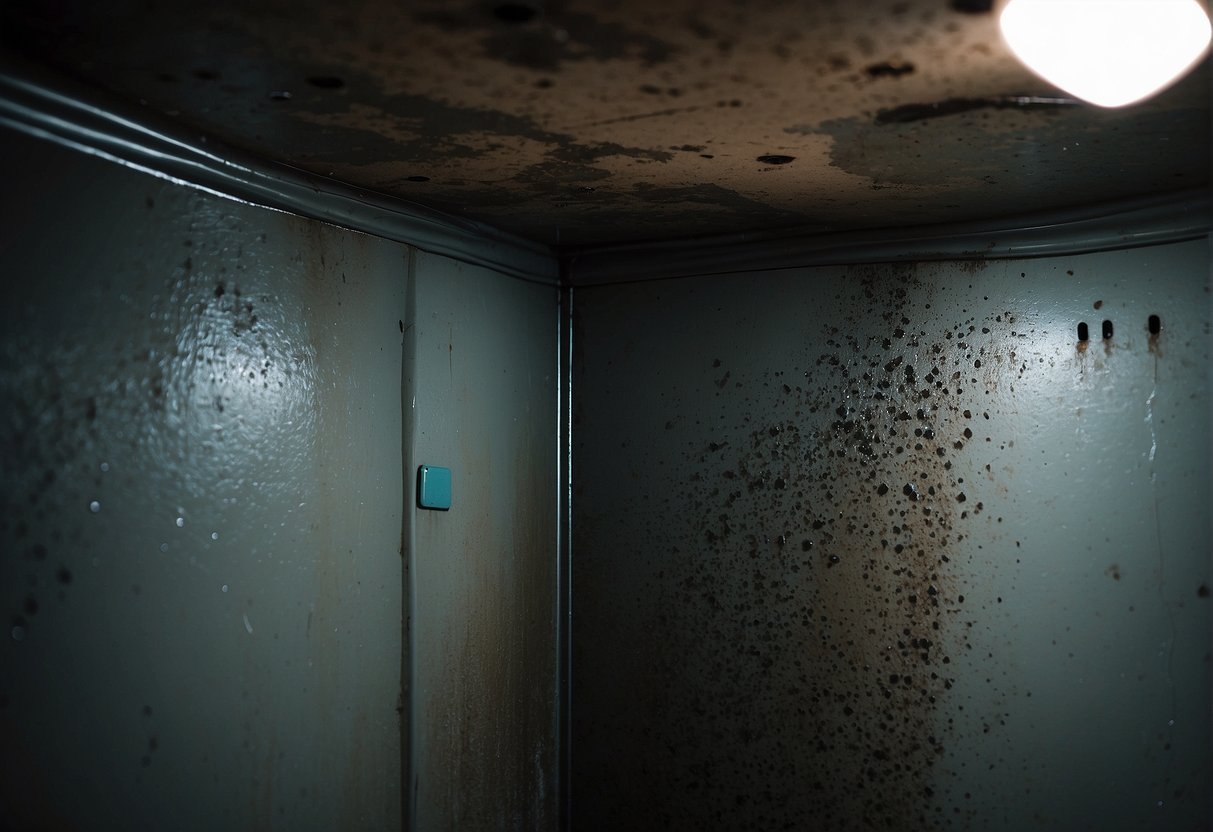
Health problems associated with black mold exposure include allergic reactions, asthma attacks, and in more severe cases, respiratory infections. These health issues arise because black mold spores contain mycotoxins that, when inhaled or ingested, can be toxic.
Symptoms of black mold exposure can vary from skin irritation to nasal stuffiness, wheezing, and in some cases, more serious symptoms like memory loss or pulmonary hemorrhage, though the latter are less common.
Preventing black mold growth is crucial to maintaining a healthy living environment. To mitigate the risk of mold proliferation, it is imperative to control moisture levels, ensure good air circulation, and repair water leaks in buildings.
If mold is found, the removal process should be conducted with caution to prevent the dispersal of spores and further exposure. Non-toxic methods, such as the use of natural cleaning agents like tea tree oil or grapefruit seed extract, can be effective in treating small areas, whereas larger infestations may require professional remediation services.
What Is Black Mold?
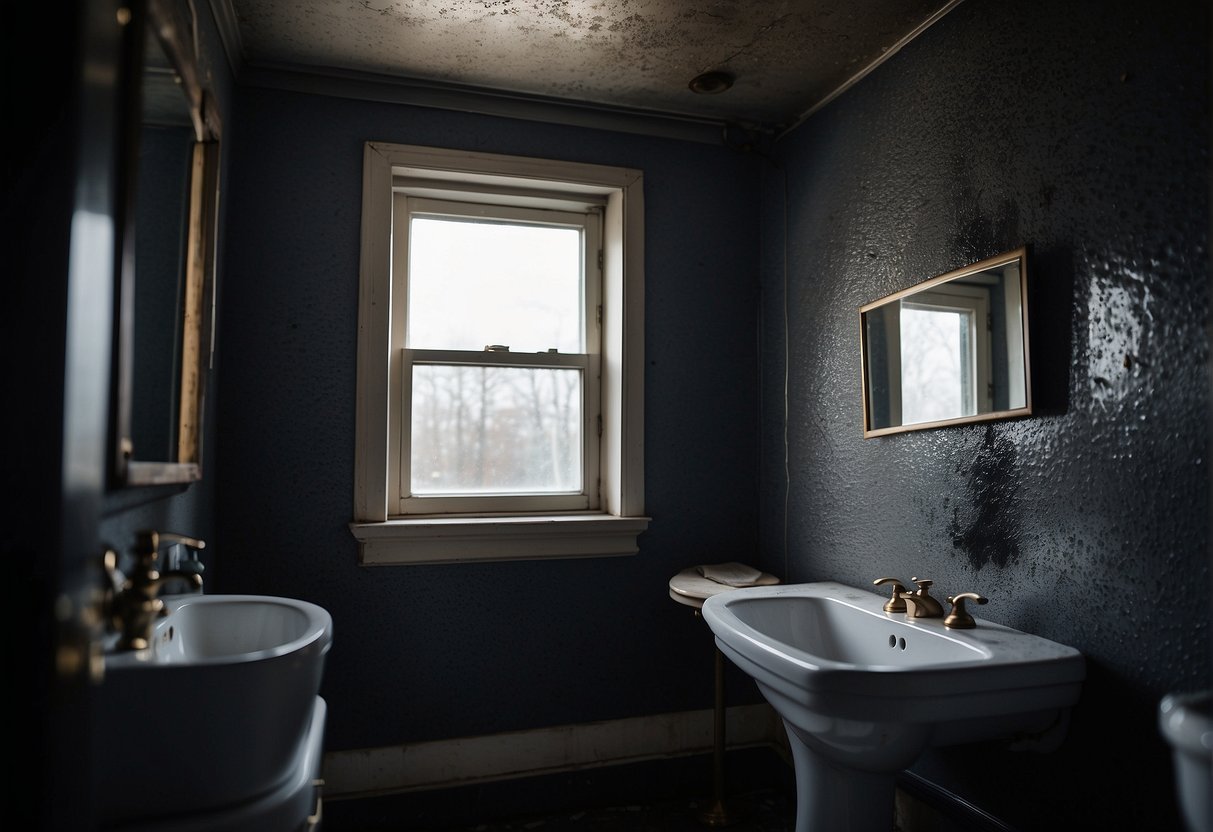
Black Mold, scientifically known as Stachybotrys Chartarum, is a type of fungus that thrives in moist environments and is notable for its dark green to black coloration. This mold is often associated with poor indoor air quality and can be found in areas that have sustained water damage or have high humidity levels.
Stachybotrys Chartarum Characteristics
- Color and Texture: Stachybotrys Chartarum is distinctly dark green or black, with a slimy texture when moist. When deprived of water, it can appear powdery.
- Toxin Production: This species of mold is capable of producing mycotoxins, which are toxic chemicals that may pose health risks when inhaled or ingested.
- Growth Requirements: It requires a consistent source of moisture for growth, making damp or wet materials rich in cellulose—such as paper, wood, and drywall—ideal substrates.
Common Locations and Environments
Preferred Environments:
- High Humidity: Locations with humidity levels exceeding 55%.
- Water-Damaged Areas: Environments affected by leaks, floods, or condensation.
- Consistent Moisture: Places where moisture is prevalent and persistent.
Typical Growth Locations:
- Basements: Often cool and damp, basements provide the perfect environment for mold growth.
- Bathrooms: Frequent use of water and poor ventilation create ideal conditions for mold.
- Areas with Cellulose Materials: Places with exposed paper, wood, or fiberboard are prime targets for this mold.
By being aware of these characteristics and locations, individuals can better identify and address potential black mold issues within their environments.
Health Implications of Black Mold Exposure
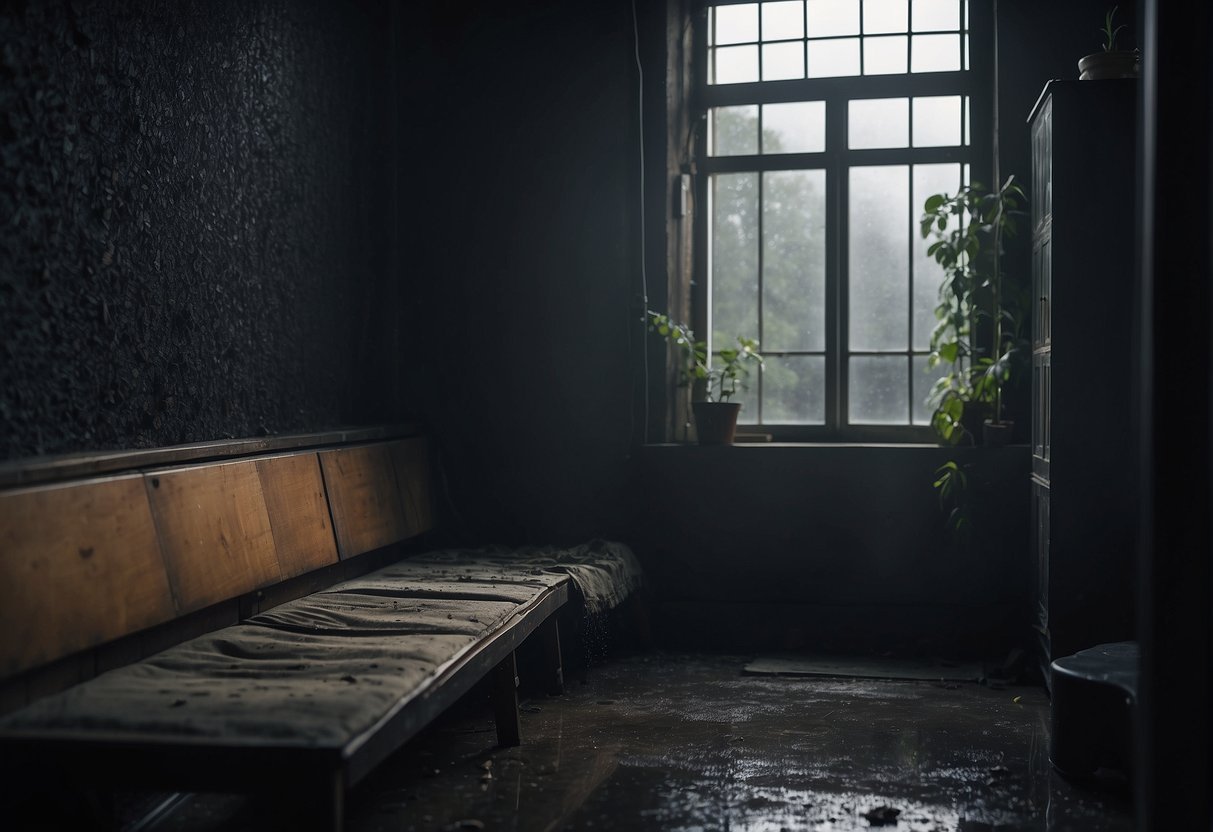
Exposure to black mold can lead to a range of health issues, particularly affecting the respiratory system and triggering allergic reactions. Certain groups, like children and those with compromised immune systems, might experience more severe consequences.
Respiratory Symptoms
Black mold exposure often results in respiratory symptoms due to the inhalation of mold spores. Individuals may experience:
- Coughing and sneezing
- Wheezing and shortness of breath
- Nasal congestion
- Asthma attacks in people with asthma
Allergic Reactions and Mold Allergies
Allergic reactions are common upon exposure to black mold. The body’s immune response may include:
- Histamine release, leading to itchy eyes and skin rash
- Allergic rhinitis with a runny nose and sneezing An established mold allergy can exacerbate these symptoms, often requiring medical management.
Severe Health Conditions
Chronic or high levels of exposure to black mold might produce toxic mold effects due to mycotoxins. Severe health conditions can include:
- Mold poisoning with symptoms like fatigue, memory loss, and severe headaches
- Respiratory infections and inflammation
- Heightened risk of infant pulmonary hemorrhage in extreme cases
Children and Infants Vulnerability
Children and particularly infants are more vulnerable to black mold exposure. Their developing immune systems make them susceptible to:
- More intense allergic reactions and asthma symptoms
- Potential for long-term health issues from chronic exposure such as developmental delays or persistent respiratory disease
Identifying Black Mold Growth in Homes
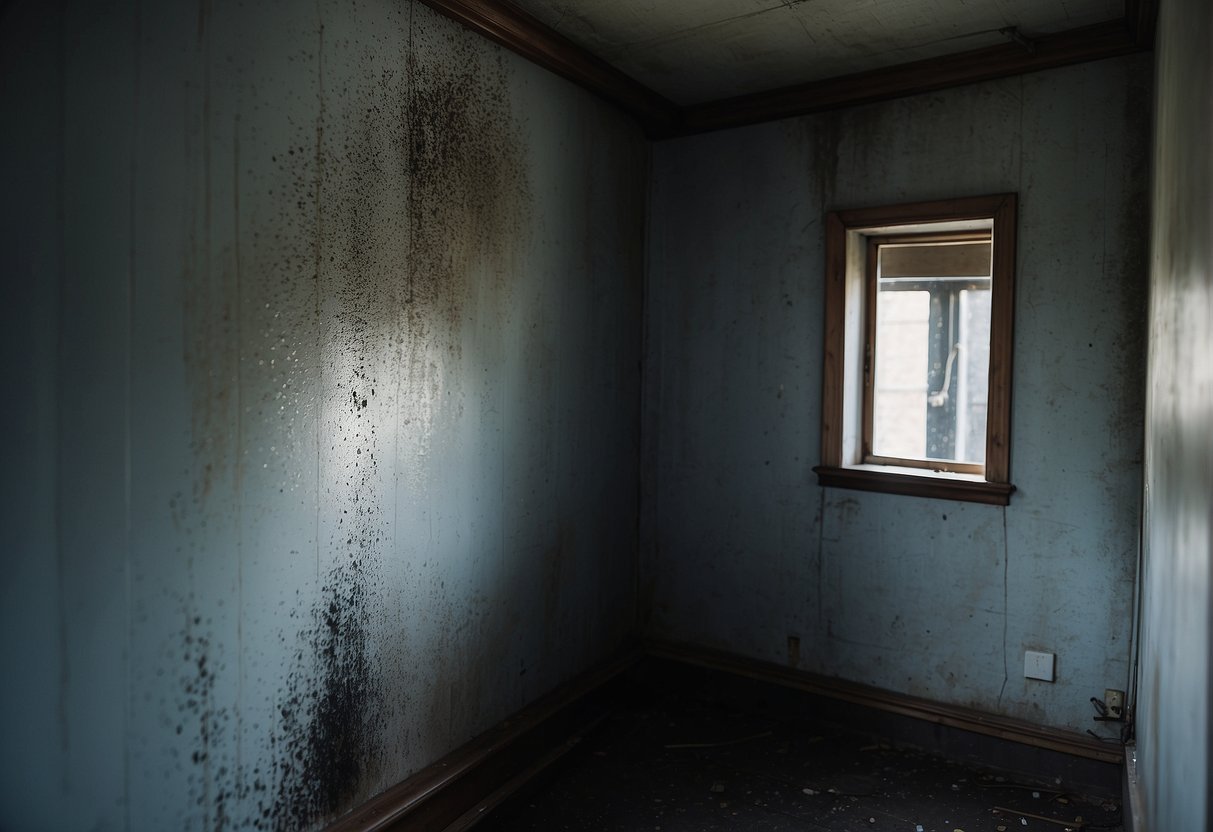
When investigating homes for black mold, it’s critical to be aware of specific signs and to inspect common growth sites. Early detection is key to preventing adverse health effects and property damage.
Typical Signs and Smells
One of the most indicative signs of black mold is a persistent musty smell, which suggests the presence of mold even when it’s not visible. Spores released by mold often produce this distinct odor, which can permeate throughout the home.
If the smell is stronger in certain areas, this may point to a concentrated source of mold growth. Additionally, if occupants experience consistent respiratory issues or allergic reactions, this can also be a sign that mold spores are present in the environment.
Mold Growth can be instigated by water leaks or condensation, often due to high levels of humidity. Identifying these issues promptly can prevent mold from taking hold or spreading. A diligent search for locations where leaks or condensation occur, especially in warm, humid regions of the home, is vital.
Visual Identification and Locations
Mold typically has a distinct appearance and can be identified by looking for greenish-black patches on surfaces. It grows in various patterns but is often seen in circular colonies that can range from less than an inch to several inches across. The following locations are common hotspots for mold growth:
- Walls: Especially near areas where water leaks or condensation form.
- Wallpaper: Mold can grow behind wallpaper, which can peel or discolor when infested.
- Bathrooms: Due to high humidity and frequent temperature changes.
- Basements and crawl spaces: Where poor ventilation and damp conditions often occur.
To visually inspect for mold:
- Start by examining areas where water leaks have occurred.
- Look behind wallpaper or beneath papers filed away, especially if they feel damp to the touch.
- Examine corners and crevices, particularly in warm, humid areas.
- Search for discolored patches or spots, as mold can appear in various hues with a textured surface.
Remember, mold thrives in environments where moisture is present, so investigating any place that meets these conditions should be a priority.
Dealing with Black Mold
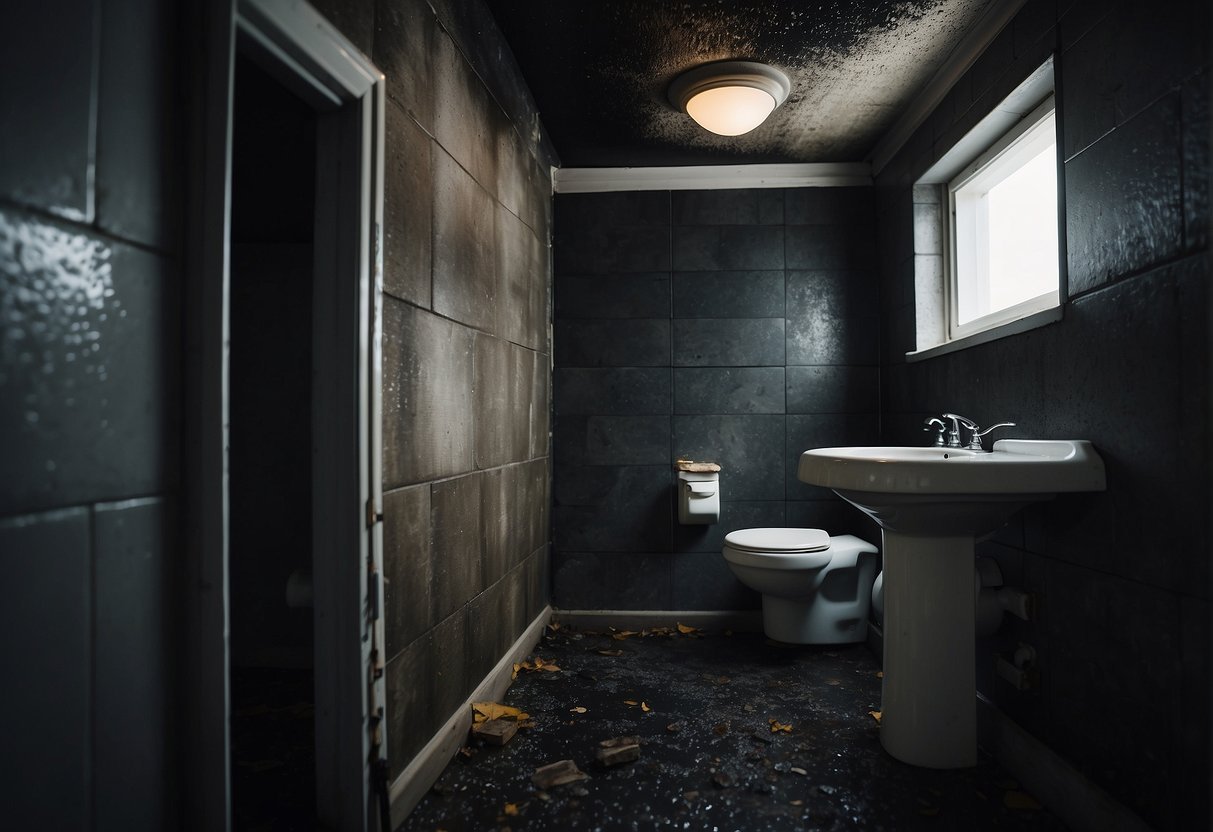
When black mold appears in a home, it presents a real challenge. It is important to address the moisture source, clean affected areas properly, and consider professional help if the infestation is extensive. Following specific steps and precautions can ensure effective mold management.
Prevention Strategies
Controlling moisture levels in the home is crucial for mold prevention. Homeowners can use dehumidifiers to maintain indoor humidity levels below 50%. Adequate ventilation, particularly in areas like bathrooms and kitchens where moisture is common, is also important. Routine checks of pipes and fixtures to prevent leaks can further reduce mold risks.
Table: Mold Prevention Checklist
| Strategy | Implementation |
|---|---|
| Moisture Control | Use dehumidifiers and air conditioners |
| Ventilation | Install and use exhaust fans |
| Leak Prevention | Regularly inspect pipes and fixtures |
| Temperature Control | Keep temperature consistent to reduce condensation |
| Routine Cleaning | Clean and dry any wet areas within 48 hours |
Cleaning and Removal Procedures
The first step in mold removal is to wear protective gear, including gloves, masks, and goggles, to prevent contact with harmful spores. Hard surfaces with mold should be cleaned using a mixture of detergent and water.
For porous surfaces, where black mold can penetrate deeper, non-ammonia cleaners or a baking soda solution can be effective. After the cleaning procedure, surfaces should be dried thoroughly to prevent mold from returning.
List of Cleaning Supplies
- Gloves
- N95 mask or respirator
- Goggles
- Detergent
- Scrub brush
- Baking soda
- Clean water
- Dry cloth
Professional Remediation Services
For extensive mold issues or if health problems arise from the mold exposure, professional remediation services may be necessary. These experts have the training, experience, and equipment to handle severe mold problems safely.
They can also suggest structural changes to help prevent future mold growth. It is recommended to consult the Environmental Protection Agency (EPA) guidelines or hire professionals for mold remediation.
Criteria for Professional Help
- Size of Mold Area: Larger than 10 square feet
- Type of Surface: Porous materials like drywall or insulation
- Health Impact: Presence of allergies or respiratory symptoms
- Mold Cause: Unresolved water damage
By adhering to these strategies and procedures, homeowners can effectively manage black mold in their living spaces.
Regulation and Health Guidelines
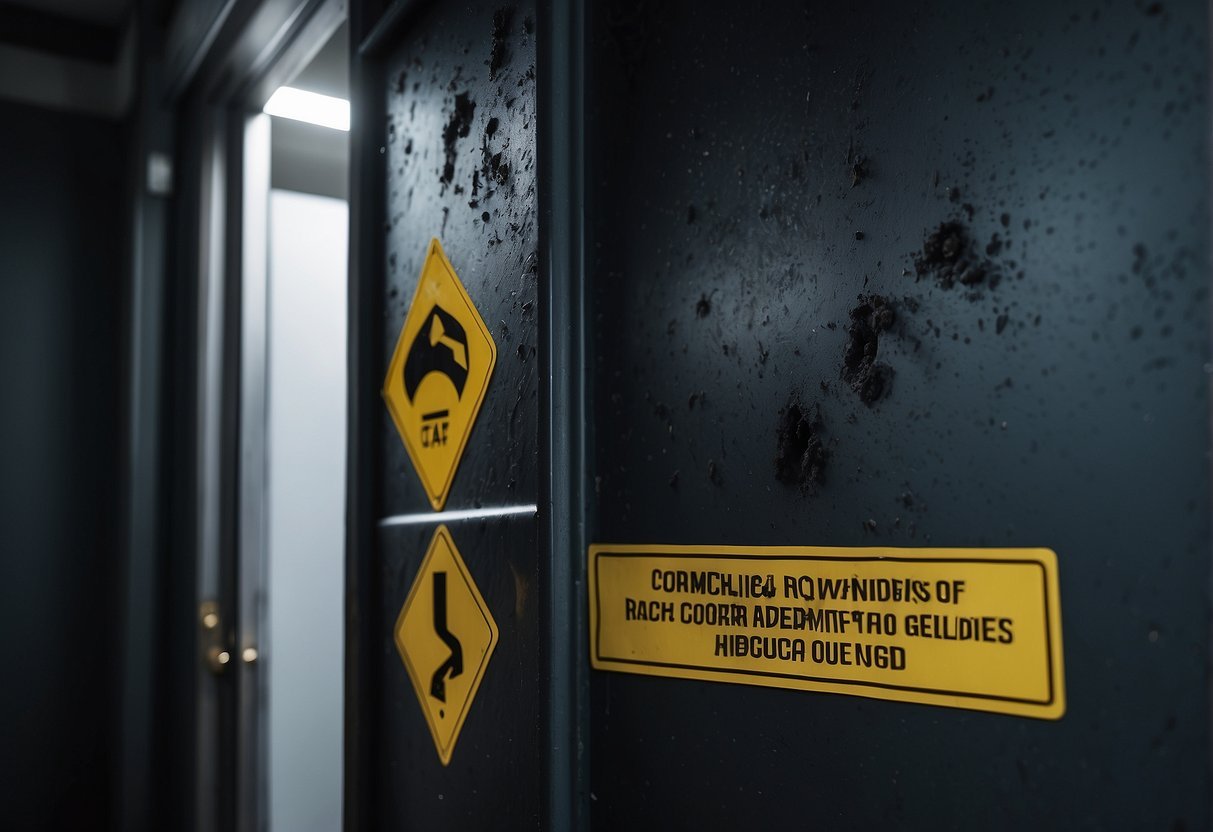
The Environmental Protection Agency (EPA) and the Centers for Disease Control and Prevention (CDC) provide guidelines to mitigate health risks associated with mold. These entities emphasize prevention, assessment, and remediation for affected areas.
EPA and CDC Recommendations
The EPA recommends that any mold growth covering more than 10 square feet should be addressed by professionals. For smaller areas, they provide guidance to safely remediate the mold.
The CDC similarly underscores the importance of removing the mold and correcting the underlying cause of moisture. They do not endorse routine health tests for mold exposure but recommend consulting a doctor if health issues arise.
- Prevention: Maintain low indoor humidity, ensure adequate ventilation.
- Moisture Control: Fix leaks, dry wet areas within 24-48 hours.
- Cleanup: Use detergent solutions for mold cleaning; avoid exposing oneself or others to moldy materials.
Professional Standards and Tests
Professionals follow standards like those outlined by the American Industrial Hygiene Association (AIHA) and the Institute of Inspection, Cleaning and Restoration Certification (IICRC) for safe mold remediation. While no standardized blood test exists for mold exposure, doctors may perform tests to rule out other health conditions related to symptoms experienced by an individual.
- Assessment: Determine the extent of mold infiltration; use moisture meters and infrared cameras.
- Remediation: Contain the area; use proper personal protective equipment (PPE).
- Post-remediation verification: Ensure the thorough removal of mold from the treated area and verify that the original sources of moisture have been addressed to prevent recurrence.